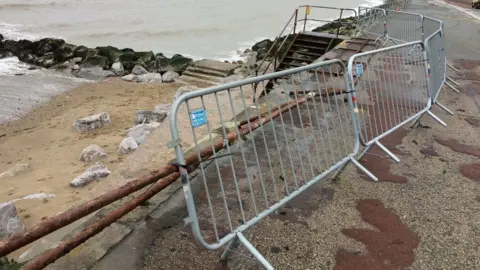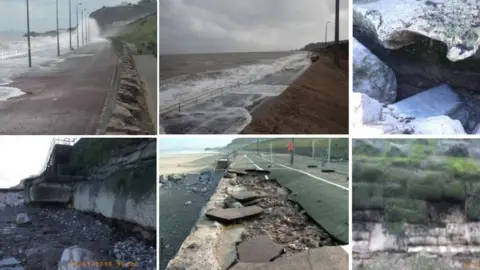Weather and storm defences: Who pays when sea walls crumble?
 Conwy council
Conwy councilClimate change is never far from the headlines - and for some - it is a lot closer to home.
In Conwy county, there is mounting concern for coastal defences in the town of Old Colwyn - with warnings the local authority can no longer afford spending up to £40,000 a year just patching up the Victorian promenade.
Worst-case scenarios suggest the prom could be shut permanently, as higher tides spill over sea walls.
In the longer term, the main rail line from Chester to Holyhead would be under threat - so would the A55 trunk road.
So, is the problem being tackled and what are the options?
What has happened?

About 60% of the Welsh population lives on or near the coast.
According to the Wales Audit Office, 208,000 properties are at risk of flooding from rivers or the sea.
In the stretch of coast running from the Great Orme in Llandudno to the Mersey estuary, 34,600 properties are at risk.
It has prompted action - especially in Conwy county.
Over the past decade, a massive coastal flood protection and regeneration scheme has been under way.
The Porth Eirias project has seen the promenade raised opposite Eirias Park in Colwyn Bay, new waterfront buildings and 500,000 sq m of sand imported to cover 0.6 miles (1km) of beach.
Work has also been carried out to improve sea walls and the promenade at Rhos-on-Sea.
So far, £28.6m has been spent on those phases of the scheme.
A further £14m has been earmarked for work in 2020, when another 500,000 sq m of sand will be dumped on beaches between Rhos and Marine Drive.
What about Old Colwyn?
 Conwy council
Conwy councilSome residents have asked whether it has been a case of burying heads in the sand and whether Old Colwyn has been ignored in favour of neighbouring Colwyn Bay.
On Tuesday, Conwy council sat down to discuss exactly this issue.
According to experts hired to examine the defences, unless action is taken, the Old Colwyn promenade will become damaged beyond repair.
It warns that without substantial work, the promenade will shut to traffic within eight years.
Within 30 or 40 years:
- The north Wales mainline railway will be eroded and the line will close
- Properties along the front between the pier and Cayley Promenade will be lost
Between 50 and 60 years:
- The loss of the A55
- More properties lost on the sea front and buildings in the centre of Colwyn Bay
What can be done?
 Conwy council
Conwy councilThe council has put forward options for another phase of coastal defence work - this time directly addressing the Old Colwyn concerns.
Under the proposals, measures would look at preventing the sea coming over defences, mitigate shoreline erosion, and protect the rail line and roads.
However, it comes with a hefty price tag - an estimated £34m - the problem then becomes how to fund that work.
The previous Conwy coastal risk management programme covering Colwyn Bay received major support from the Welsh Government - 75% of the scheme was grant-funded.
But new proposals do not fall into the same category - as it is about protecting infrastructure - rather than homes and businesses.
It means as things stand, the Welsh Government will not be making the same grant cash available.
So who pays?
Responsibility would need to be split.
- Council: £8m-10m as lead flood and coastal protection authority
- Welsh Water: £4m-5m for sewerage works to be re-routed
- Sustrans: £1m-2m to re-route the national cycle path
- Network Rail: £20m-30m to protect the mainline railway tracks
If Network Rail took the decision not to invest then ultimately, it would mean the A55 would be affected and the Welsh Government could face the bill for the road.
On balance, analysts argue rail bosses would want to protect their investments - the alternative would be the end of the line - quite literally - for direct rail services to a large swathe of north Wales.
Why not simply walk away?

In some parts of Wales, the coastal management solution to flood risks has been just that.
The Gwynedd seaside village of Fairbourne faces exactly that fate as it is being "decommissioned".
From about 2050, the area's sea defences will no longer be maintained and the sea will be allowed to reclaim the village - which is home to about 1,000 people.
The decision is based on what are known as shoreline management plans - every part of the Welsh coastline has one, developed over years by government, local authorities and the communities themselves.
In the plan for Fairbourne, the decision has been "managed retreat".
But for Old Colwyn, it is a different story.
The town, with 8,000 residents, and the strategic importance of road and rail links, means the message is "hold the line" - defences will be protected, as far as budgets allow.
What next?
As the body responsible for co-ordinating the flood management response, Conwy council is pushing for a summit of all the main partners involved at Old Colwyn.
On Tuesday, a scrutiny committee backed a call for a meeting to bring together the council with Network Rail, Welsh Water, Sustrans and Welsh Government representatives.
The decision will be considered by the council's cabinet at a meeting on 22 October.
The focus is simple: "Securing capital funding to improve coastal defences at Old Colwyn".

This piece has been inspired by questions from BBC Wales News readers.
Is there anything you've always wanted to know?
Use this form to send us your questions:
If you are reading this page on the BBC News app, you will need to visit the mobile version of the BBC website to submit your question on this topic.
We may get in touch if we decide to follow up on your suggestion.
